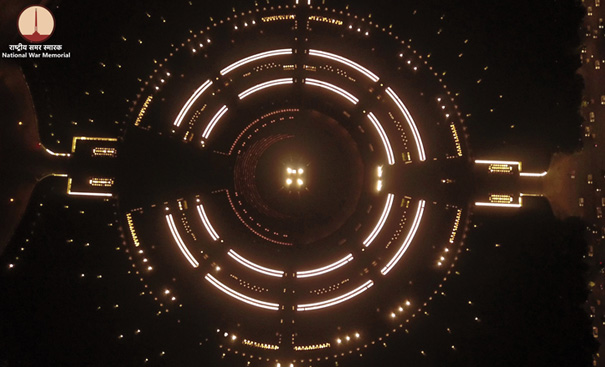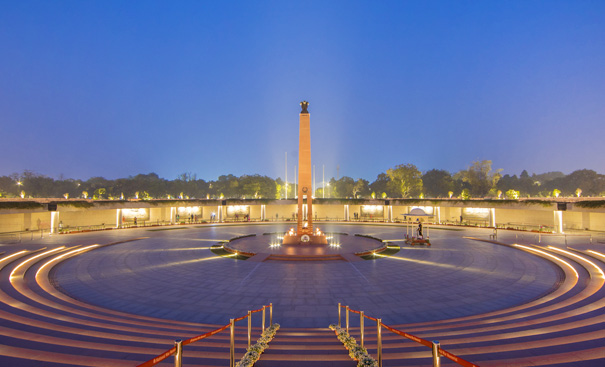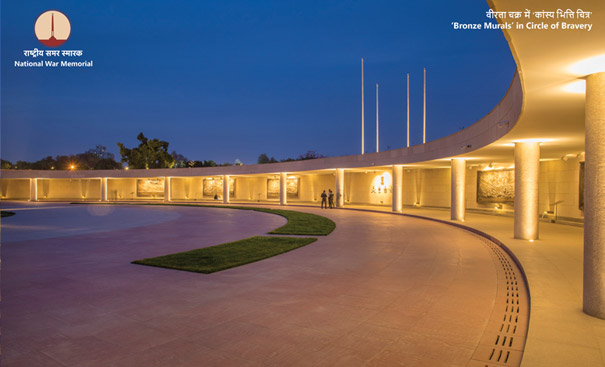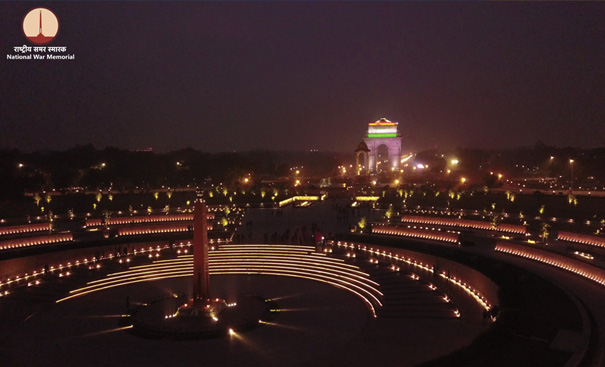History of National War Memorial
The iconic India Gate in Lutyen's Delhi was constructed in 1931 by erstwhile British empire to commemorate the Battle Casualty (Fatal) of India during World War I as well as Third Anglo-Afghan War. It stands tall as a must visit monument for visitors in New Delhi. Out of over 83,000 Indians who laid down their lives, India Gate bears 13,516 names, etched all over the monument.
- Amar Jawan
Jyoti (AJJ) - Post Independence
Era Battle Casualties - Decision to Construct
National War Memorial - Process of
Creation
Amar Jawan Jyoti (AJJ)
An inverted bayonet with a helmet structure along with Amar Jawan Jyoti was installed over night under the Arch of India Gate in January 1972 to commemorate India's victory in India - Pakistan War 1971 and as Nation's tribute to our brave soldiers who laid down their lives. After inception of National War Memorial, the Amar Jawan Jyoti merged with eternal flame of National War Memorial on 21 January 2022. Wreaths have been laid at AJJ ever since by dignitaries at various occasions, including by foreign dignitaries.
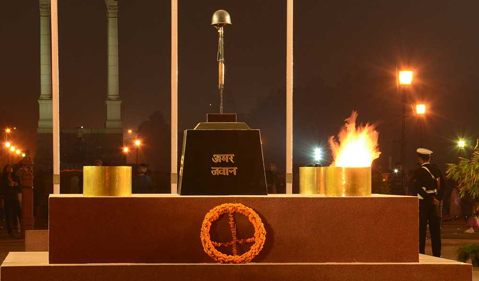
Post Independence Era Battle Casualties
Post India's independence on 15th August 1947, our country has been involved in many conflicts of different magnitudes and participated in innumerable operations both inland and overseas. Our country continues to engage in counter-terrorism operations and proxy war from across the front resulting in number of battle casualties. While a number of area/battle specific memorials are built across the country, but no memorial existed that was all - encompassing.
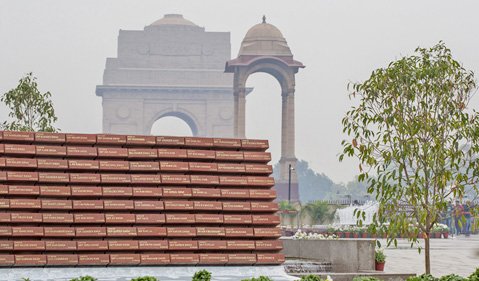
Decision to Construct National War Memorial
The requirement to construct a National War Memorial had been under consideration since 1961 at the apex level. The consideration acquired momentum in 2014 and after a deliberate process the Union Cabinet on 07 October 2015 approved construction of National War Memorial & Museum (NWM&M) within the National capital's Lutyen's zone. Taking into consideration the existing ceremonial practices at India Gate and AJJ, area East of the India Gate around the Canopy at 'C' Hexagon in New Delhi was found to be the most suited site for the Memorial.
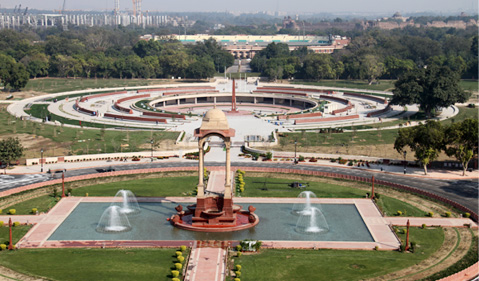
Process of Creation
A two stage Global competition to select a suitable design for the Memorial was held in 2016-17. Shri Yogesh Chandrasan of WeBe Design Lab Chennai, won the Global competition for his design and was appointed Project Consultant. Necessary sanctions from statutory besides consultations with urban bodies in Delhi were held and a Detailed Project Report was prepared. M/s NCC Ltd was awarded the contract on 25 January 2018 and Headquarters Integrated Defence Staff (HQ IDS) executed the project on behalf of Ministry of Defence. The monument was dedicated by the Nation to the Armed Forces of India on 25 Feb 2019 by Hon'ble Prime Minister Shri Narendra Modi.
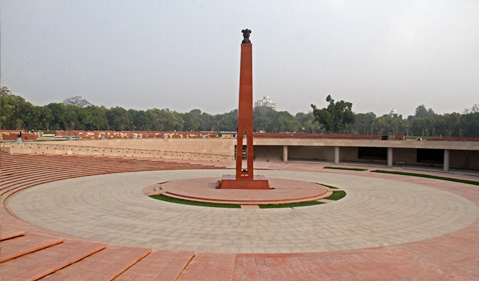
Concept
The memorial complex is in harmony with the existing layout and symmetry of the majestic Kartavya Path and Central Vista. Solemnity of the ambience is maintained with an emphasis on landscaping and the simplicity of architecture. Apart from the main memorial, there is dedicated area for busts of soldiers who have been conferred with 'Param Vir Chakra,' the nation's highest gallantry award. The design of the main memorial exemplifies that supreme sacrifice made by a soldier in the line of duty not only makes him immortal but also depicts that the spirit of a soldier remains eternal. The memorial has distinct scheme of concentric circles:

Amar Chakra
Circle of Immortality. This has an Obelisk with Eternal Flame. The flame symbolises the immortality of the spirit of fallen soldiers with the assurance that the Nation will never forget their sacrifices.

Veerta Chakra
Circle of Bravery. The Third circle depicts the Bravery of Indian forces in the form of a covered gallery that exhibits six murals crafted in bronze depicting valiant battle actions of Indian Armed Forces.

Tyag Chakra
Circle of Sacrifice. The circular concentric walls of honour, which symbolise the ancient war formation 'Chakravyuh'. The walls are clad with granite tablets where an independent granite tablet is dedicated to each soldier who has made the supreme sacrifice. Each name on the tablet is etched in golden letters.

Raksha Chakra
Circle of Protection. The outermost circle made of rows of trees in the Raksha Chakra is a reassurance to the citizens of the country about their safety against any threat, with each tree representing the soldiers who ensure the territorial integrity of the Nation, round the clock.
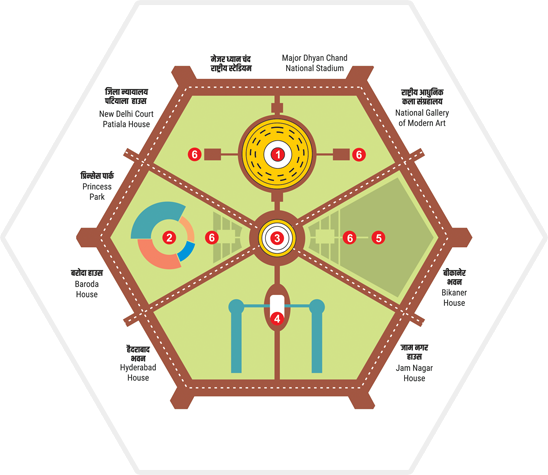
Layout of Memorial C-Hexagon
- National War Memorial
- Param Yodhdha Sthal
- Canopy
- India Gate
- Children's Park
- Conveniences
Significance
A war memorial is a building, monument, statue or an edifice to celebrate a war or victory or to commemorate those who died or were injured in war. It provides an opportunity to the visitors to develop a conscious connect with the site, with the institution and people in whose memory the structure is built. The memorial attempts to invoke a deep and moving experience and serves as symbol of inspiration for future generations.
Significance. Since-Independence, more than 26,000 soldiers of the Indian Armed Forces have made the supreme sacrifice to defend the sovereignty and integrity of the country. The National War Memorial thus represents the gratitude of a nation to its Armed Forces. The Memorial will help strengthen the sense of belonging, high moral values, sacrifice and national pride in our citizens. It shall stand testimony to the sacrifices made by our soldiers during various conflicts, United Nations Operations, Humanitarian Assistance and Disaster Response Operations since Independence.
Remarks & MessagesThe Lighting Scheme
The lighting plan is sewn into the fabric of the overall design of National War Memorial to highlight the details, materials and colours within the complete landscape. It seamlessly integrates with the architecture so as to provide an immersive and evocative environment, thus enhancing the emotive and visual experience.
The lighting design is the catalyst which transforms the monumental landscape from day to night at sunset. It provides a dynamic scheme creating a visual hierarchy by focusing on points of interest and accentuating different areas using suitable lighting fixtures. The warm white light and the lighting design creates a warm ambience for the visitors.
Lighting Design Layers
Raksha Chakra
The theme reflects solidity and duality. Lights highlight 'Rakshaks'.
Tyag Chakra
The light illuminates inscribed names of the soldiers to highlight supreme sacrifices.
Veerta Chakra
The theme emphasises celebration of bravery and victory.
Amar Chakra
Glow & aura is created around the Obelisk and Eternal Flame as a sign of purity.
Highlights at National War Memorial
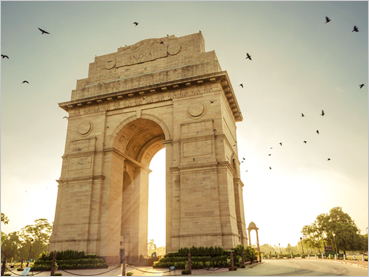
Located Due East
of India Gate
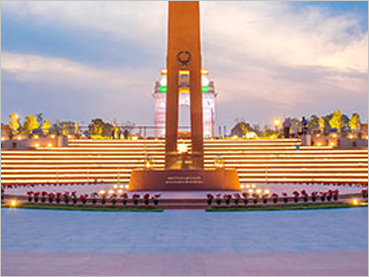
Amar Chakra with the Obelisk & Eternal Flame
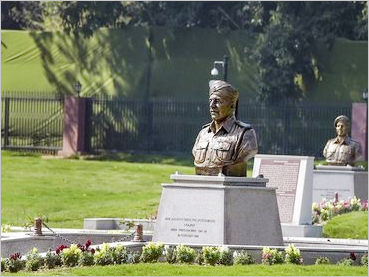
Param Yodha Sthal with Sprawling Lawns
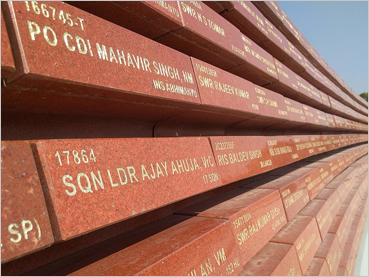
Tyag Chakra with 29,760 Granite Tablets
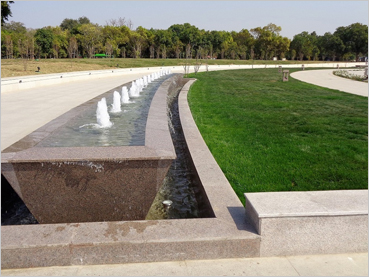
Raksha Chakra landscaped with Trees
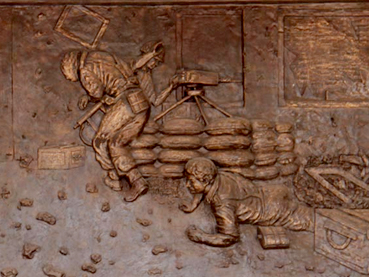
Veerta Chakra with six Bronze Murals
Amenities at National War Memorial
-
Gallery
-
Souvenirs (Smarika)
-
Conveniences
-
Public Plazas
-
Public Utilities
-
Urban Corridor
-
Adequate Benches
-
Disabled Friendly
-
Walkways
-
Drinking Water
-
First Aid
-
Help Desk
-
Digital Panels
-
Drop & Pick Up Zones
-
e- Rickshaws
-
Wheel Chairs
Activities at National War Memorial
Routine Activities
- Retreat Drill just before sunset on daily basis.
- Change of Guard Ceremony and band display before Retreat Drill every Sunday.
- Band displays at Public Plaza on important occasions.
- Public / Routine Visitors.
- Organised visits by Scout & Guides, NCC Cadets, Schools, National Integration Tours, Colleges etc.
Ceremonial Functions
- Republic Day 26 Jan
- Independence Day15 Aug
- Kargil Diwas (26th Jul)26 Jul
- Vijay Diwas16 Dec
- Army, Air Force & Navy Days
- On Visits of Senior Dignitaries
- On Regimental / Corps Days
Wreath is being laid every day during Retreat Ceremony by invited next of kin of the Battle Casualties
- Ceremonial wreath laying to commemorate important days
- Wreath laying by senior dignitaries from foreign countries


